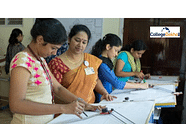
Pattern puzzles are an integral part of the non verbal section in the Common Law Admission Test (CLAT). Questions from CLAT non verbal puzzle section are often challenging, yet the most scoring. To score good marks, you must possess a sharp analytical mind and clear reasoning skills. Otherwise, the tricky questions from this section, especially solving the pattern puzzles, become difficult or time consuming. These pattern puzzle questions are set in a way to test your ability to identify patterns, visualize changes, or how fast you can apply your logical reasoning skills. By practicing the right approach, you will find it easier to identify the question patterns and how to approach them. Read the article in detail to know more about how to solve pattern puzzles in CLAT nonverbal reasoning section and avoid unnecessary mistakes.
Also Check -
CLAT 2026 English Questions: 5-Year Trend Analysis, Difficulty Level, Important Topics
Most Common Types of Pattern Puzzles Asked in CLAT
Pattern puzzles deal with a series of design, shapes, or figures arranged in a matrix or sequence. The most common types of pattern puzzles asked in CLAT exam include the following:Mirror images
Water images
Figure series
Paper cutting and folding
Dot and line patterns
Matrix reasoning
The type of questions asked in the nonverbal reasoning section of
CLAT 2026
includes figure matching, series completion, odd one out, small numbers, and embedded figures. Each question should be approached in different ways. It is important that you regularly practice all these types of questions to understand what should be the CLAT reasoning shortcuts are and identify the pattern quickly.
Also Check -
Important Topics for CLAT 2026 Logical Reasoning
Step-by-Step Approach to Solve Pattern Puzzles in CLAT Non Verbal Reasoning
The best way to solve the CLAT nonverbal reasoning section is to keep a structured approach. Here are a few tips and tricks on how to solve pattern puzzles in CLAT non verbal reasoning section.
Carefully Observe Patterns
Start to understand the questions by carefully observing the figures, or changes in tone, rotations, or any repetitions. Identify the direction of movement, like clockwise or anticlockwise, and then do a logical comparison. Try to eliminate choices that do not fit the sequence. This step wise approach will reduce confusion and improve the accuracy.
Look for Cues
To solve the nonverbal reasoning from the CLAT exam correctly, look for simple cues like an increase or decrease in shapes, rotation of angles, symmetry, shading differences, and movement in any sequence. While counting the elements, check for the presence of any alternate patterns, the spotting of mirrors, and any flipped figures. Following these practices will help you to solve the questions quickly, and the chances of errors will be less.
Quick Links:
| CLAT sample papers | CLAT practice tests |
|---|---|
| CLAT 2026 syllabus | CLAT previous year question papers |
Check for Consistency
Once you have identified a pattern, check if it is consistent with all the figures in the given series. Sometimes you might find trick questions or puzzles involving multiple steps, such as addition of dots and rotation combined in one. If your theory for any given figure fails, you should reconsider other combinations or apply alternate rules.
Practice Time Management for Pattern-Based Questions
Since the CLAT is a time bound entrance exam, you cannot afford to lose much time on any particular question. It is important that you regularly practice time management skills. The questions from the nonverbal reasoning section are tricky and might take up a lot of time if you do not know how to approach. Allocate a fixed amount of time for each question. Start with the puzzle questions first and visit the tricky or difficult questions later. Develop a quick scanning habit so that you can identify the pattern of questions and thus save a lot of time.
Quick Links:
| CLAT 2026 exam pattern | Best books for CLAT 2026 preparation |
|---|---|
| CLAT 2026 preparation | CLAT 2026 mock test |
Improve Accuracy and Speed
As we all know, practice makes us perfect. Regularly sit and solve a variety of CLAT nonverbal reasoning questions to build familiarity. Additionally, this will also increase your speed of attempting the paper and help you identify different patterns. Some of the best ways to solve pattern puzzles in the CLAT nonverbal reasoning section is to attempt as many mock tests as possible, solve the previous year's question papers, and practice regularly.
In conclusion, it can be said that some of the most effective ways to solve pattern puzzles in the CLAT nonverbal reasoning section are to practice regularly, solve previous year papers, and keep a calm mind. Identify the pattern and try to pick up quick ways to solve the problem. For more articles related to Law, follow CollegeDekho!
Related Articles
| How Meditation and Relaxation Techniques Can Boost Your CLAT Prep | Tips to Prepare for CLAT 2026 Quantitative Techniques Section |
|---|
For any query, head to our QnA Zone or fill out our Common Application Form . Stay tuned to CollegeDekho for more such updates!
Are you feeling lost and unsure about what career path to take after completing 12th standard?
Say goodbye to confusion and hello to a bright future!

FAQs
Yes, the pattern puzzles are an important part of the CLAT preparation. The puzzle questions are asked in the nonverbal reasoning section of the CLAT questionnaire. It is important to focus on scoring well in this section since it will determine the overall rank of the students.
Ideally, you should not spend more than 30 to 40 seconds stuck on any question. The pattern puzzles are one of the trickiest portions of the CLAT nonverbal section, and hence, spending a lot of time on one question will become problematic.
Some of the best tricks to increase the speed in solving puzzles from the CLAT nonverbal reasoning section include practicing regularly, attempting mock tests, identifying patterns, and using tricks based on the nature of the question.
Was this article helpful?




















Similar Articles
Expected rank for 30 marks in SLAT 2026
UGC NET Law December 2025 Most Important Topics for Last Minute Revision
Expected rank for 40 marks in SLAT 2026
Expected rank for 50 marks in SLAT 2026
What is a Good Score in SLAT 2026?
Government Jobs after LLB